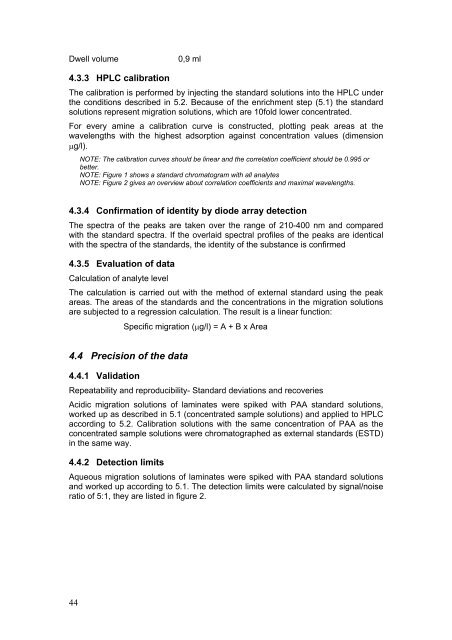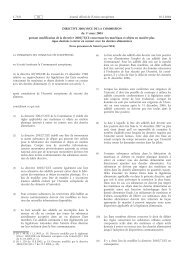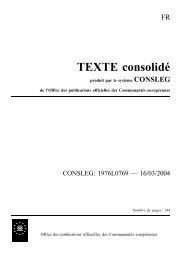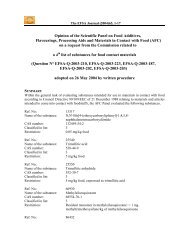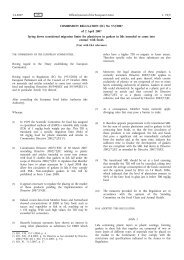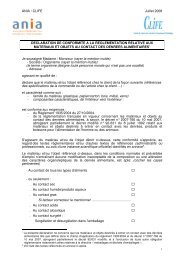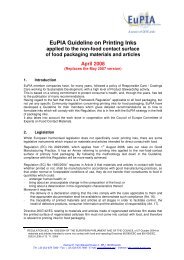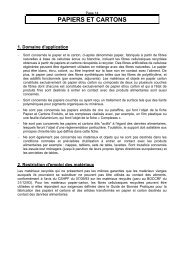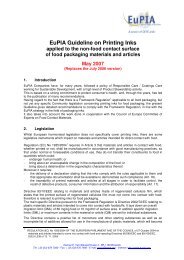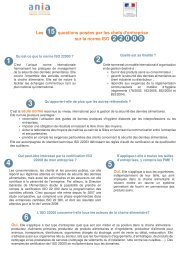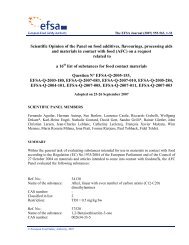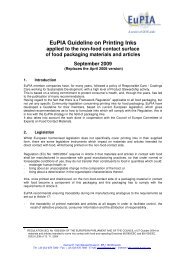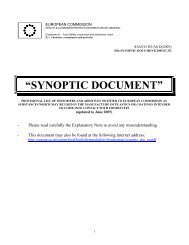Technical guidelines on testing the migration of primary aromatic ...
Technical guidelines on testing the migration of primary aromatic ...
Technical guidelines on testing the migration of primary aromatic ...
Create successful ePaper yourself
Turn your PDF publications into a flip-book with our unique Google optimized e-Paper software.
Dwell volume0,9 ml4.3.3 HPLC calibrati<strong>on</strong>The calibrati<strong>on</strong> is performed by injecting <strong>the</strong> standard soluti<strong>on</strong>s into <strong>the</strong> HPLC under<strong>the</strong> c<strong>on</strong>diti<strong>on</strong>s described in 5.2. Because <strong>of</strong> <strong>the</strong> enrichment step (5.1) <strong>the</strong> standardsoluti<strong>on</strong>s represent migrati<strong>on</strong> soluti<strong>on</strong>s, which are 10fold lower c<strong>on</strong>centrated.For every amine a calibrati<strong>on</strong> curve is c<strong>on</strong>structed, plotting peak areas at <strong>the</strong>wavelengths with <strong>the</strong> highest adsorpti<strong>on</strong> against c<strong>on</strong>centrati<strong>on</strong> values (dimensi<strong>on</strong>μg/l).NOTE: The calibrati<strong>on</strong> curves should be linear and <strong>the</strong> correlati<strong>on</strong> coefficient should be 0.995 orbetter.NOTE: Figure 1 shows a standard chromatogram with all analytesNOTE: Figure 2 gives an overview about correlati<strong>on</strong> coefficients and maximal wavelengths.4.3.4 C<strong>on</strong>firmati<strong>on</strong> <strong>of</strong> identity by diode array detecti<strong>on</strong>The spectra <strong>of</strong> <strong>the</strong> peaks are taken over <strong>the</strong> range <strong>of</strong> 210-400 nm and comparedwith <strong>the</strong> standard spectra. If <strong>the</strong> overlaid spectral pr<strong>of</strong>iles <strong>of</strong> <strong>the</strong> peaks are identicalwith <strong>the</strong> spectra <strong>of</strong> <strong>the</strong> standards, <strong>the</strong> identity <strong>of</strong> <strong>the</strong> substance is c<strong>on</strong>firmed4.3.5 Evaluati<strong>on</strong> <strong>of</strong> dataCalculati<strong>on</strong> <strong>of</strong> analyte levelThe calculati<strong>on</strong> is carried out with <strong>the</strong> method <strong>of</strong> external standard using <strong>the</strong> peakareas. The areas <strong>of</strong> <strong>the</strong> standards and <strong>the</strong> c<strong>on</strong>centrati<strong>on</strong>s in <strong>the</strong> migrati<strong>on</strong> soluti<strong>on</strong>sare subjected to a regressi<strong>on</strong> calculati<strong>on</strong>. The result is a linear functi<strong>on</strong>:Specific migrati<strong>on</strong> (μg/l) = A + B x Area4.4 Precisi<strong>on</strong> <strong>of</strong> <strong>the</strong> data4.4.1 Validati<strong>on</strong>Repeatability and reproducibility- Standard deviati<strong>on</strong>s and recoveriesAcidic migrati<strong>on</strong> soluti<strong>on</strong>s <strong>of</strong> laminates were spiked with PAA standard soluti<strong>on</strong>s,worked up as described in 5.1 (c<strong>on</strong>centrated sample soluti<strong>on</strong>s) and applied to HPLCaccording to 5.2. Calibrati<strong>on</strong> soluti<strong>on</strong>s with <strong>the</strong> same c<strong>on</strong>centrati<strong>on</strong> <strong>of</strong> PAA as <strong>the</strong>c<strong>on</strong>centrated sample soluti<strong>on</strong>s were chromatographed as external standards (ESTD)in <strong>the</strong> same way.4.4.2 Detecti<strong>on</strong> limitsAqueous migrati<strong>on</strong> soluti<strong>on</strong>s <strong>of</strong> laminates were spiked with PAA standard soluti<strong>on</strong>sand worked up according to 5.1. The detecti<strong>on</strong> limits were calculated by signal/noiseratio <strong>of</strong> 5:1, <strong>the</strong>y are listed in figure 2.44


